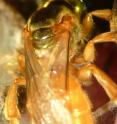Live-in domestics: Mites as maids in tropical rainforest sweat bee nests
Mites not only inhabit the dust bunnies under the bed, they also occupy the nests of tropical sweat bees where they keep fungi in check. Bees and their young are healthier when mites live-in, report researchers from the Smithsonian Tropical Research Institute in Panama and the University of Texas at Austin. Mutually beneficial cleaning relationships have been documented for shrimps and fish that eat parasites on larger fish, but this is the first confirmation of a cleaning relationship between two different species on land. Tropical sweat bees in the genus Megalopta tunnel into rotten wood, excavating cells for their young that they feed with nectar and pollen. Researchers working at field sites throughout Panama noticed that sweat-bee nests sometimes housed mites and that more young bees died in nests that did not contain mites than in nests that did.
"The mutualistic nature of bee-mite symbioses was hypothesized repeatedly but had never been demonstrated empirically," said Natalia Biani, short-term fellow in Staff Scientist William Wcislo's lab at STRI and graduate student in professor Ulrich Mueller's lab at the University of Texas, Austin.
Biani placed the contents of the brood cells in water and plated the liquid on Petri dishes in order to count the number of fungal colonies from nests with and without mites. "When we took away the mites, the bee nests got dirtier. When we added mites, fungus counts went down. It is pretty clear that the mites clean up the cells where the young are growing," Biani said. In return, the mites receive a clean, dry home, fungus to eat and free bee rides to new nests.
Source: Smithsonian Tropical Research Institute
Other sources
- Live-in domestics: Mites as maids in tropical rainforest sweat bee nestsfrom PhysorgMon, 20 Apr 2009, 16:07:53 UTC


